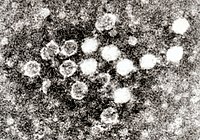Parvovirus B19
| Parvovirus B19 | ||||||||||||||||||||
|---|---|---|---|---|---|---|---|---|---|---|---|---|---|---|---|---|---|---|---|---|

Parvovirus B19 ( TEM representation) |
||||||||||||||||||||
| Systematics | ||||||||||||||||||||
|
||||||||||||||||||||
| Taxonomic characteristics | ||||||||||||||||||||
|
||||||||||||||||||||
| Scientific name | ||||||||||||||||||||
| Primate erythroparvovirus 1 | ||||||||||||||||||||
| Short name | ||||||||||||||||||||
| B19V | ||||||||||||||||||||
| Left | ||||||||||||||||||||
|
Primate erythroparvovirus 1 , formerly Parvovirus B19 , Human parvovirus B19 or Erythrovirus B19 (from Latin parvus = small and Greek ερυθρό , erythro = red), is a small single-stranded DNA virus from the family of parvoviruses and the causative agent of rubella ( erythema infectiosum ). In 1974 it was discovered by chance by the Australian virologist Yvonne Cossart . It takes its name from the laboratory sample with the number B19 in which it was found. It has a diameter of only 20 to 24 nm , making it one of the smallest known viruses.
morphology
The virion consists of an icosahedral capsid , which is composed of multiples of two different virus proteins (VP1 and VP2). A linear, single-stranded DNA is enclosed by this capsid. Another viral protein is covalently bound to the DNA. The capsid often packs the DNA incompletely, so that part of the DNA thread protrudes from the capsid. The virion of the parvovirus B19 is characterized by a very high stability towards environmental factors and detergents .
The viral genome is 5000 to 5500 nucleotides in size. The sequence variability is low. So far, three genotypes have been identified (genotype 1 to 3) that occur in different regions of the world.
Biological importance
Parvovirus B19 is the causative agent of rubella ( erythema infectiosum ). Due to lifelong immunity after infection, the disease is common in children. Parvovirus B19 only reproduces in the erythroblasts , the precursor cells of the red blood cells ( erythrocytes ) in the bone marrow . The infection therefore triggers a temporary anemia , which in immunocompromised or already anemic patients can lead to complications and even death, but which can be treated with timely blood transfusions. Patients who already suffered from anemia - for example sickle cell anemia - before they were infected with parvovirus B19 have an increased risk of an aplastic crisis . Spontaneous abortions and other complications such as hydrops fetalis , which can seriously damage the fetus if not recognized, can also occur during pregnancy .
Infection with Parvovirus B19 results in viraemia with very high virus concentrations of 10 12 to 10 14 genomes / ml blood; the viruses are also present in saliva and urine. However, the symptoms set in with a delay in the course of the immune response . The formation of antibodies and thus many immune complexes causes what is known as acute symmetrical polyarthropathy , a painful joint inflammation. After this first phase with very high virus titers , a second phase follows in some people, in which the infection can pass into a permanent (persistent) state. The viral load is then much lower at 10 2 to 10 4 particles / ml blood, but the viruses then also attack other target cells such as lymphocytes , macrophages , synovial cells , endothelial cells and tissues such as the heart, liver and skin. The virus is then likely to be absorbed by antibodies; the original receptors no longer play an essential role.
In these patients, the genomes of the viruses are locally limited in parts of the skin, tonsils, myocardium and other tissues, but infectious particles are not. A reactivation of the viruses may be possible, but not yet proven. Long ago infections can be detected by the presence of antibodies against the structural proteins VP1 and VP2. The number of these seropositive people is around 70% by the age of 65.
Seroprevalence in Germany
| Age | % seropositive |
|---|---|
| 4 - 6 years | 35% |
| 10-15 years | 58% |
| 25-29 years | 70% |
| 65 - 69 years | 79% |
See also
swell
- ED Heegaard, KE Brown: Human parvovirus B19 . Clin Microbiol Rev (2002) 15 (3): pp. 485-505 PMID 12097253 .
Individual evidence
- ↑ a b c d e f ICTV: ICTV Taxonomy history: Primate erythroparvovirus 1 , EC 51, Berlin, Germany, July 2019; Email ratification March 2020 (MSL # 35)
- ↑ YE Cossart, AM Field, B. Cant, D. Widdows: Parvovirus-like particles in human sera. Lancet (1975) i: 72-73 PMID 46024 .